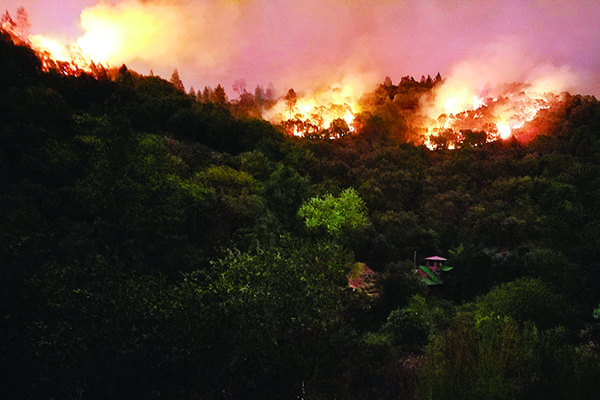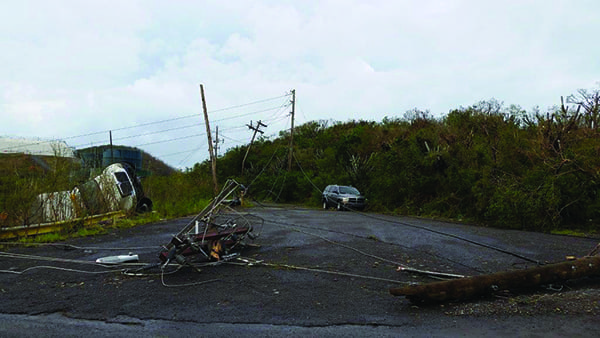Backup Power for Critical Loads Can Save Lives and Money
In a modern economy increasingly dependent on electric power, blackouts can wreak havoc when the loads are critical to life, business, and even a comfortable lifestyle. The problem may be growing, but there are ways to respond.
On September 13, 2017, powerful Category 3 Hurricane Irma stormed into south Florida’s Broward County, between Fort Lauderdale and Miami. It was a killer.
Among the victims were a dozen residents of a local nursing home, the Rehabilitation Center at Hollywood Hills. While the storm didn’t completely knock out power to the nursing home, it did take out the transformer for the circuit that served the facility’s air conditioning system. Twelve elderly residents died of heat exhaustion, as the temperature spike after the hurricane hit 92F. The Florida tragedy was a grisly reminder that failure to have a backup power system for critical loads doesn’t just cost dollars and create inconvenience—it can cost lives.
 |
|
1. A fire burns out of control along a ridge during the California wildfires in Rough and Ready, Calif., Oct. 12, 2017. Some California power companies have implemented deenergization strategies during dry, high-wind periods to reduce the risk of fires caused by power lines, and other transmission and distribution equipment. Source: California National Guard |
Another example of a lack of backup power came when San Francisco-based Pacific Gas and Electric (PG&E) in 2019 repeatedly deenergized large segments of its territory for public safety reasons, leaving many customers without power for extended periods. The utility said it was necessary to turn off electricity because gusty winds and dry conditions could result in wildfires from its aged transmission equipment. The policy was a response to devastating fires in 2017 and 2018 that destroyed entire communities, killed at least 85, and caused billions of dollars in damages (Figure 1). The fires pushed PG&E into Chapter 11 bankruptcy reorganization, which is still unresolved.
To the south, Southern California Edison took some of the same safety precautions. In both cases, the result was uproar among consumers—and a spike in the sales of gasoline-fueled backup generators.
In facing power cuts during high winds in California’s dry tinder territory, thousands fled to where they could have electricity. Many others were able to stay put, without power from the grid. They had backup power supplies. But some of those who had personal backup generation also suffered. The San Francisco Chronicle reported that home gasoline generators have also caused fires. And dangerous carbon monoxide emissions produced by portable units can be lethal.
The newspaper quoted El Dorado County Fire Chief Lloyd Ogan, “The longer we do this, shutting power off, the more we’re going to roll the dice on the additional risks that exist because of alternative forms of power and lighting. We have traded one risk for a whole new set of risks.”
What Is Critical?
Backup power for critical operations has become a high-profile topic in recent years, with the discussions ranging from the enormous threats of large-scale, long-lasting outages that could wreak widespread havoc, to mundane personal disruptions that are perceived as critical. Examples include disruptions or power fluctuations to major industrial customers; high-tech computer-driven businesses; health care facilities; and residential customers.
Virtually every customer of an electric utility believes that his or her load is critical. That’s a reasonable response to a major outage. Some loads are more critical, but that’s a difficult proposition to offer to anyone whose life is disrupted by a sustained power outage. Hospitals, nursing homes, emergency response, critical manufacturers, by most estimates, would go to the front of the critical load queue.
 |
|
2. Hurricane Irma caused significant damage to power lines in St. Thomas, Virgin Islands. This image taken by a Federal Emergency Management Agency (FEMA) first-responder captures some of the damage to electrical distribution infrastructure on Sept. 7, 2017. Irma was a Category 5 storm when it made landfall in the Virgin Islands. Source: Ron Alexander Jr. / Western Area Power Administration |
This topic has long been on the minds of government officials. In 2014, following several severe hurricanes, the Department of Homeland Security’s Federal Emergency Management Agency (FEMA) published “Emergency Power Systems for Critical Facilities: A Best Practices Approach to Improving Reliability.” FEMA said, “There is a significant likelihood that utility power will not be available for an extended period of time during severe natural hazard events [Figure 2]. Thus, it is necessary for critical facilities to have reliable sources of sustained electrical power to achieve continued operation.”
FEMA defined critical facilities as “a building that is intended to remain operational in the event of extreme environmental loading from flood, wind, snow, earthquakes, or tsunamis. In model building codes, they are often referred to as essential buildings.”
The agency said, “Most critical facilities rely on a public utility grid, where power is typically transmitted and distributed by way of networked systems over long distances between where the power is generated and where it is consumed. The long-distance transmission and distribution of electricity leaves emergency power supplies vulnerable to a variety of natural hazards, even for sophisticated redundant networks.”
Acknowledging that most building codes address the need for emergency power resources, FEMA, drawing on National Fire Protection Association standards, offered a model building code to provide for backup power for critical loads. The agency said, “Over the last 50 years, numerous building codes have been developed. In the past, individual States, and occasionally individual cities, developed their own codes. Because of the level of effort required to write and maintain effective building codes, private organizations were formed with the charge to write and maintain ‘model’ building codes.”
After about 2000, the three major regional building codes merged into a common code, the International Building Code (IBC). FEMA built on that in its model code aimed at backup power. The FEMA document pertains to building new facilities to withstand power outages for critical loads. But most loads are not new and covered by the IBC, and must figure out how to prevent outages from degrading their operations that can economically devastate their businesses or risk public health.
Diesel Service and Supply, a Colorado company that provides backup power solutions to commercial and industrial customers, has posited, “In an emergency, is your commercial building prepared? What would happen if a major storm hit your area with a large-scale power failure that resulted in complete loss of power? If your commercial facility is anything like many others across the nation, it is likely ill-prepared to handle a sustained power failure.”
Is the Risk Increasing?
The Washington Post’s Capital Weather Gang reported in 2014 that the non-profit Climate Central said its analysis, based on Department of Energy (DOE) and North American Electric Reliability Corp. data, showed “a stunning ten-fold increase in outages” between 1984 and 2012. Some of that is clearly due to increased outage reporting over that 28-year period, as electric supply has become increasingly important to critical loads, including computer-driven loads impacted by power quality issues.
Also increasing the number of outages is the aging U.S. power grid infrastructure and the heightened focus by state and local regulators on utility maintenance and oversight practices. That has played a role in the intense attention to grid infrastructure in California following the series of catastrophic fires in fire-prone, arid areas of the Golden State.
Changes in the climate from global warming may also be a factor. The 2014 Climate Central report observed, “Climate change is, at most, partially responsible for this recent increase in major power outages, which is a product of an aging grid serving greater electricity demand, and an increase in storms and extreme weather events that damage this system.” A warming world may be producing “more fuel for increasingly intense and violent storms, heat waves, and wildfires.”
There is some expert skepticism about the link between climate and extreme weather. Climate scientist Roger Pielke Jr. at the University of Colorado-Boulder has long argued that there is no empirical evidence, so far, that such weather phenomena have actually increased recently in a statistically significant fashion. He doesn’t deny global warming but cautions that weather phenomena don’t provide evidence.
Diesel Service and Supply said, “The U.S. power grid has been slowly improving its load capacity and monitoring technology for years so the ability to handle the increasing load has greatly improved, but this does little in the overall unplanned outage department.”
In 2018, the DOE’s Energy Information Administration (EIA) took a look at electric distribution outage data by state, measuring the frequency and duration of power interruptions. The agency found, “In 2016, customers experienced an average of 1.3 interruptions and went without power for four hours during the year. Although some distribution customers have backup generators that provide auxiliary power, most customers are without electricity when outages occur.”
Most short-term power outages are at the distribution level, as the EIA acknowledged. While high-voltage transmission outages caused by hurricanes and large wildfires garner the most media coverage, the day-to-day distribution system accounts for the bulk of customer outages.
The EIA looked at both the frequency of power outages and their duration. The agency also distinguished between outages “without major events” by utility types. According to the analysis, the majority of outages were minor, while the duration between minor and major outages was about equal. Municipal utilities fared the best for both frequency and duration, while electric cooperatives were the worst, with investor-owned utilities falling in between. The rural co-op ratings may reflect their rural characteristic, with longer distribution lines over more difficult terrain.
What to Do?
Diesel Service and Supply, which has an obvious commercial interest in providing backup power, has some commonsense advice for commercial electric customers. It also applies well to all electric customers who face hardships if power fails. And that’s almost everybody.
Be Prepared. The company says, “The time to prepare is before an emergency—not after. Being proactive in protecting your commercial facility prior to a power outage occurring is a must.”
Make a Plan. “No matter what type of facility you are managing (manufacturing plant, data center, telecom packaging plant, agricultural operation, processing facility, commercial building, etc.) you should have a thorough plan in place to deal with power outages of all types—from short term to extended.”
The company notes that “in today’s world of high reliance on electricity and power, it’s not will a failure happen, it’s when.” ■
—Kennedy Maize is a long-time energy journalist and a frequent contributor to POWER.